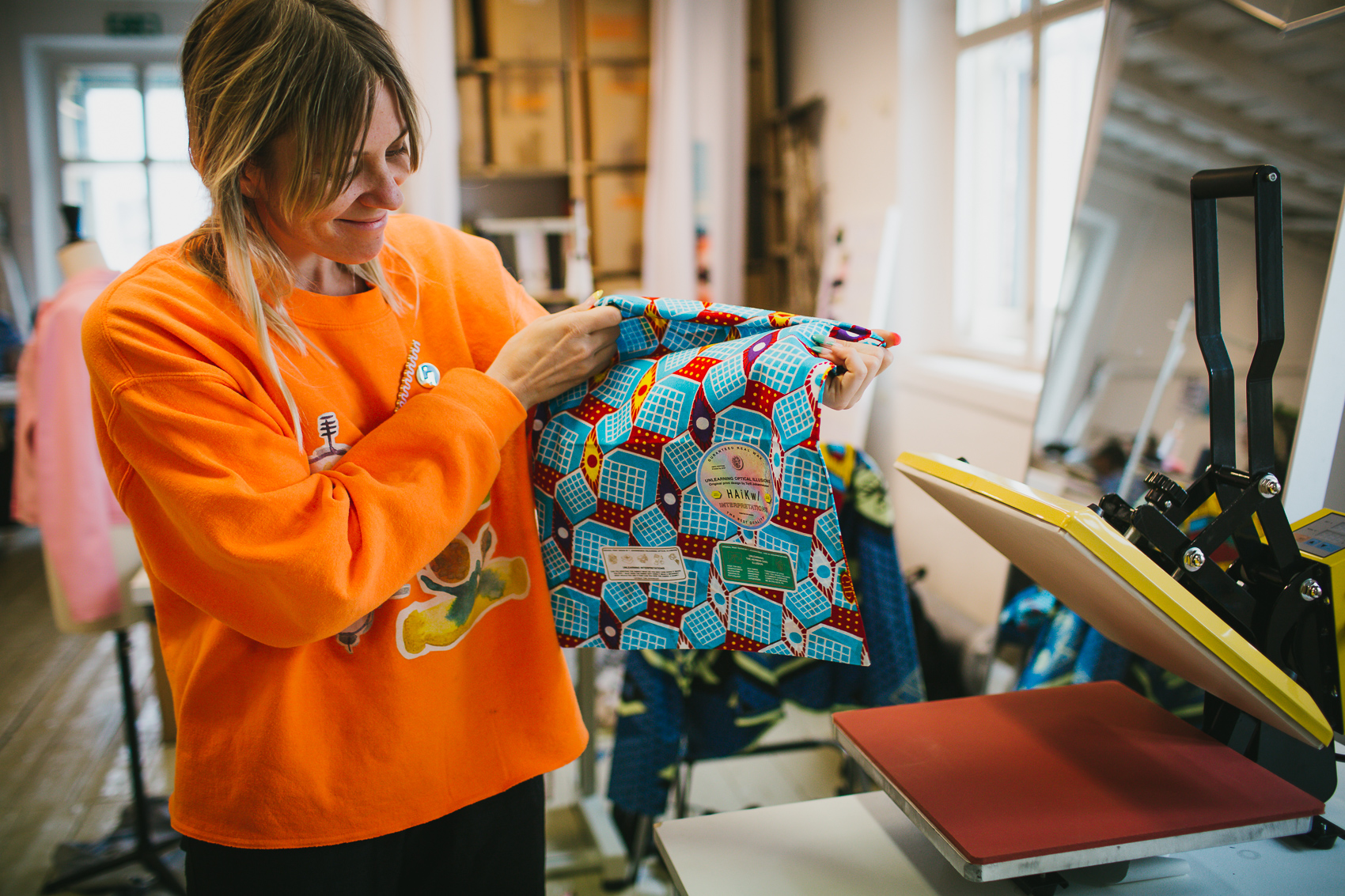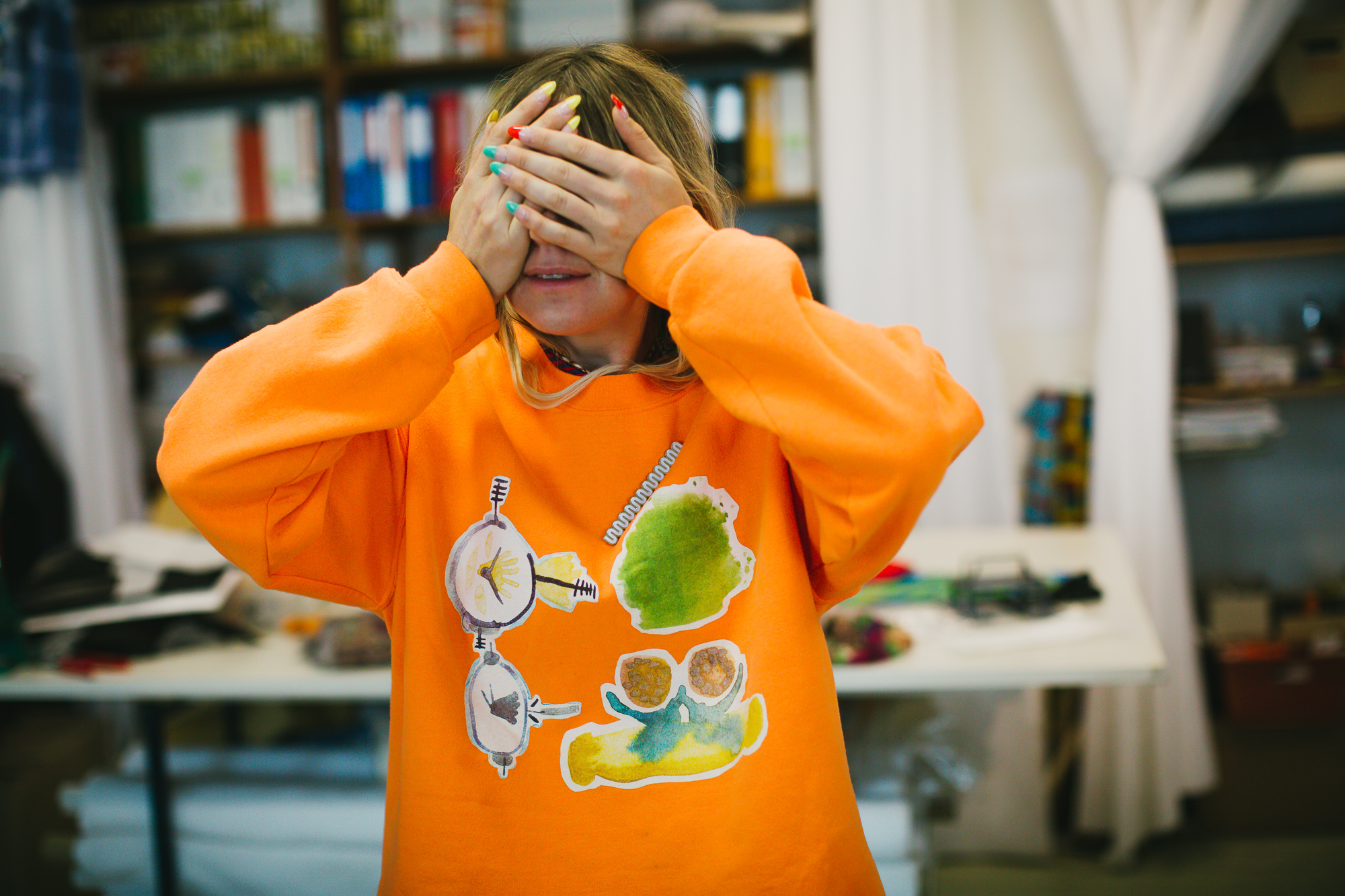—
“To haik means to hitch hike in Norwegian and the name directly reflects the labels method of work. Three designers came together to play together and explore common interests and aesthetics in fashion.”
IDA FALCK ØIEN
–
In a few words, describe yourself and your practice.
HAiKw/ is a Norwegian clothing label for men and women. To haik means to hitch hike in Norwegian and the name directly reflects the labels method of work. Three designers came together to play together and explore common interests and aesthetics in fashion. To cover more ground we invited even more people along – taking hitch hikers – people from various fields of work join in on a seasonal basis and make the collections with the original three. The world we live in is run on collaboration – it's reassuring to repeat that: you are not alone.
–
If you were to share one piece of advice with those who aspire to do what you do, what would it be?
To like every task you have to do, just don’t rank the tasks. Design is only one part of running a label like ours. You have to wear so many hats and you have to be able to tolerate them all, love them or at least laugh about them.
It’s great to work with and for others from time to time. Not only does it help the economy while working on establishing a new company but it’s so interesting and rewarding to visit with other companies for a bit to sort of get out of the bubble of your own.
–
When did you start your practice?
HAiKw/ was established in 2012 and developed into the structure that we are working under now probably through 2013 when we established the local Oslo studio to be a solid work space. Before that we were working from different corners of the world and came together through an online studio that was facilitated by using all kinds of communications platforms like phones, Skype, Dropbox and trying any new app on the market for sharing information. I sound like an ad for online communications platforms here. (haha) We should definitely be sponsored by Dropbox.
–
Is your practice how you support yourself? If not, what else are you working on to do so?
We have always done consulting for other labels or makers and we teach at the design education in Oslo from time to time. It’s great to work with and for others from time to time. Not only does it help the economy while working on establishing a new company but it’s so interesting and rewarding to visit with other companies for a bit to sort of get out of the bubble of your own. And of course working with students is always fun and challenging in the best way.
WHAT MAKES YOUR WORK UNIQUE?
I think the mix of people we work with, which is ever changing, ensures that every season holds some surprises at HAiKw/. We get fresh insights by inviting people from various fields to think together,
always bending the theme in unexpected ways.
–
How does where you live affect your work?
As we started while living in different countries: Harald Lunde Helgesen in London, Siv Støldal on a small island on the West coast of Norway and myself in LA, we love the idea of geographically covering the most ground possible. Our approach is a type of field work collecting information from people about their relationship to clothes so the more spread out we are the better we cover a variety. Doing research in LA would give quite different answers than what was collected at Tyssøy, the small island where Siv still lives. This was amazing but now Harald and I run the HAiKw/ studio in Oslo together with our press and marketing director Kristoffer Lundin. Being located in one place together has made work more steady and easy in some ways. Now people know where to find us in Oslo, we have a full time apprentice, a tailor and interns, storage and all kinds of wonderful brick and mortar facilities. We still travel a lot, like to Lithuania for the factory there, Ghana to work on the SS17, Japan or other places and everywhere we go we bring work with us and do the research for the collections on the road.
Sometimes it’s scary to be transparent but the benefits
outweigh the anxiety.
–
How do you start your process?
We always start by talking to people around us, usually in an interview format. We record interviews and transcribe them, take photos or videos depending on the subject and then create an archive that becomes the pool that everyone working on the project can access. The conversations that occur during interviews are sometimes but not always instrumental to the design outcome. This method lets us dive into a broad specter of view points and while getting us deeper into the theme, it also gives us many choices and ideas to start mulling over.
–
Who (or what) inspires you?
We are super inspired by the current scene in Oslo these days with so many amazing people working across the creative field. People like singer Nils Bech who is always bringing heartfelt and strong new works and also the iconic Jenny Hval in on-stage performances, the artist Charlie Roberts who runs Got it For Cheap Worldwide which we are a part of, the photographer Maria Pasenau, the magazine Recens run by Elise By Olsen and Tableau Magazine by Tove Sivertsen who works with other favorites like artists Maria Brinch and Tor Erik Bøe. Trollkrem, the platform for showing performance art that makes the most passionate and ambitious events, the artist Tori Wrånes who will always blow you away, our friends whose work we admire like Jim Særnblom and Eirik Sæther. There are new stylists popping up as well as other designers whose work we love, like Anne Karine Torbjørnsen and Michael Nybråten or NY-based Bror August Vestbø. Speaking of NY and on to USA- I want to mention a few amazing people that have always inspired me on a personal level - Kristin Dickson from Iko Iko and Rowena Sartin for running not only a super cool label but curating and running a gallery and shop and being the most positively warm human around, Cameron Mesirow from Glasser for doing her own thing that I happen to love, Tauba Auerbach for her multi faceted approach and amazing work from paintings to pins to organs (made with Glasser) and beyond and my old friend Dorian Raygoza who has worked with HAiKw/ more recently - he is an amazing drag artist and the best person I know at describing fashion in a profoundly fun and insightful way.
–
Are you comfortable sharing all aspects of your process?
We have been in situations more than once where the whole process was shown during the making of the collection, way before we knew ourselves what the outcome would be. Our work is research based, so we don’t design until the process has really been rolling for a while. That entails doing interviews, starting to treat the material and analyze, extract essences and so on. These things can be done in collaboration with seasonal HAiK-ers. Like during our month long stay at Bergen Kunsthall, an art center in Norway, we had an open office landscape where we discussed the theme of dresses to a broad extent together with graphic designer Jodie Gatlin of New Work Studio from LA. That meant lists of words, interviews printed, sketches for prints, testing new cuts in toile and so on. So people walked in and commented or asked questions. It made for some nice conversations and meeting points. Sometimes it’s scary to be transparent but the benefits outweigh the anxiety.
–
How has your practice changed over time? Where is it going?
In the beginning we ran the studio sort of online - three people spaced out in different places. Then we changed that to be a solid studio in one location with a satellite on a small island, which works for us. The practice might slowly develop or change a lot - it’s really up to us - but for now I think we just keep building and evolving into better, a bit bigger, stronger. We'll never change the core idea though - to work together in new constellations to make multifaceted work and collections for people to wear or view.
WHAT WOULD YOU BE DOING IF YOU WEREN'T DOING THIS?
I wish I could say I would be a doctor, but none of the choices I made through school and growing up led that way so I would still be in the artistic field I think. Or I would have loved to work with food, perhaps as a chef, which is of course also very creative.
–
What are some challenges you're facing in your practice?
Challenges come up every day, small and sometimes big. Small challenges can involve organizing a production run which we are used to and a big challenge could be dealing with a similar thing but adding little special twists like fabric being out of stock at the dealer, shipping issues, factories running out of business or any other insanely unfortunate and unforeseen conditions.
–
What is the most useful tip or advice you’ve ever been given?
I think the most basic advice that I keep hearing mentioned is to love what you do and perhaps to do one thing and do it really well. I do love what I do. I don’t really mess with the things I don’t like - but again my advice is to just to like it even if it’s not the most fun in a general expectation of what fun is supposed to be in life. In regards to doing one thing well, I feel like I never really followed that advice - we do many things pretty well I guess - and I find it more interesting personally to keep my interests broad. I guess you loose some and win some. Another well meaning advice is to be yourself and you can’t argue with that one.
–
What are you currently working on?
We have just finished an exhibition version of a live show of the SS17 collection at the gallery Rod Bianco in Oslo. We loved being able to show much more of the process and content than what a fashion show gives the opportunity for - time being an important factor here. We have started working on AW17 while rounding up production and shipping of SS17 and making arrangements for production of SS17. We are going to be showing in NY with Got it For Cheap in October so we are making a few very special T-shirts for that. The latest project is starting a book series together with a graphic designer Pati Passero that will be published by Torpedo Books. This will be a way to show so much of the underlying research that might get lost in the circus while trying to survive and selling pieces of clothing. There are the ideas and the work and then there is the communication between them - we always strive to be better at the combination of these two types of tasks.






































